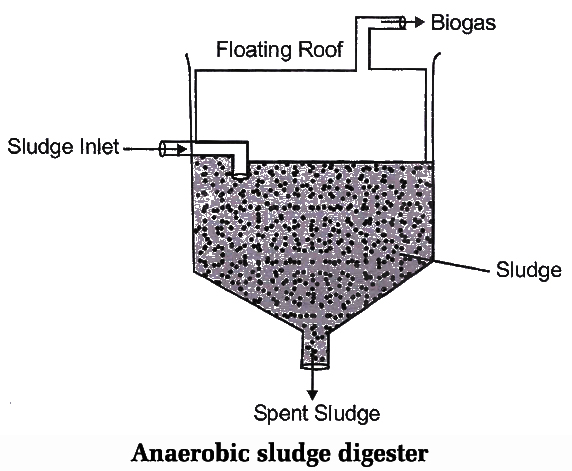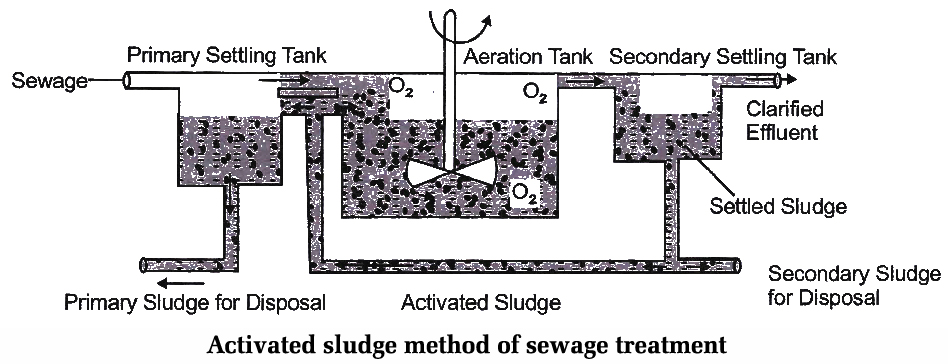- Books Name
- A TEXT OF BIOLOGY - CLASS XII
- Publication
- ACME SMART PUBLICATION
- Course
- CBSE Class 12
- Subject
- Biology
MICROBES IN SEWAGE TREATMENT
Sewage is collective noun used to represent municipal waste (both liquid and solid waste) generated in cities and towns which is carried off in sewerage.
It contains large amount of domestic water and waste including human and animal excreta, microbes and every things that enter sewerage system.
Sewage or municipal waste should not be passed into rivers, streams and other water bodies, because it not only contains human excreta and other organic wastes but a number of pathogenic microbes.
It is made less polluting by passing it through sewage treatment plants (STPs).
Treatment of waste water is done by the heterotrophic microbes naturally present in the sewage.
The various steps in sewage treatment are :
1. Primary Treatment :
It is a physical process of removal of large and small particles from sewage through sequential filtration and sedimentation.
Initially, floating debris is removed by sequential filtration, then the grit (soil and small pebbles) are removed by sedimentation.
The sewage is first shredded and churned. It is then passed through many screens or skimmers to remove large pieces of organic matter. The sewage is now passed into a large primary settling tank having a gentle slope.
Grit, sand and other heavy particles settle down.
All solids that undergo sedimentation and screened organic matter collectively constitute primary sludge.
Primary sludge can be used for preparing compost or manure directly. It can also be burnt.
The waste water (primary effluent) after removing the primary sludge contains fine organic matter. It is passed for secondary treatment.
2. Secondary Treatment or Biological Treatment :
It involves biological process of microbial degradation of organic matter.
There are three main methods use of oxidation tanks, trickling filter method and activated sludge method.
In activated sludge method the effluent from primary settling tank is passed into an aeration tank. It is agitated mechanically.
Air is pumped into the effluent. It contains a large population of aerobic heterotrophic microbes, including bacteria and fungi.
The microbes form flocs (masses of bacteria associated with fungal filaments).
The BOD of the effluent rises initially and the treatment continues till the BOD decrease to a certain level.
It is taken to secondary settling tank where the flocs undergo sedimentation.
The sediment is called activated sludge (This can be the inoculant for next secondary treatment).
The supernatant is allowed to pass into rivers and streams.
Activated sludge is taken to anaerobic sludge digesters alongwith the primary sludge.
Here, anaerobic microbes act upon organic matter to first produce monomers and then organic acids.
This convert the latter into a mixture of gases like methane, hydrogen sulphide and carbon dioxide.
The gaseous mixture is called biogas. It is inflammable and can be used as a source of energy.
The spent sludge is used as manure, land fill or can be burnt. Pathogens present in the original sewage get killed during anaerobic digestion.


3. Tertiary Treatment :
It is physiochemical process in which chlorine gas, zirconium, ozone gas, perchlorate salts, UV rays or reverse osmosis etc are used to remove DDT, pesticides, pathogens and remove turbidity in waste water. It is preferred when water is to be used for domestic use.
River Action Plans :
Prior to 1985, very few cities and towns had sewage treatment plants.
The municipal waste water was discharged directly into rivers resulting in their pollution and high incidence of water borne diseases.
In order to protect the major rivers of India from sewage pollution, the Ministry of Environment and Forests, has initiated development of sewage treatment plants under the National River Conservation Authority, e.g., Ganga Action Plan (GAP), Yamuna Action Plan, etc.

 ACME SMART PUBLICATION
ACME SMART PUBLICATION
